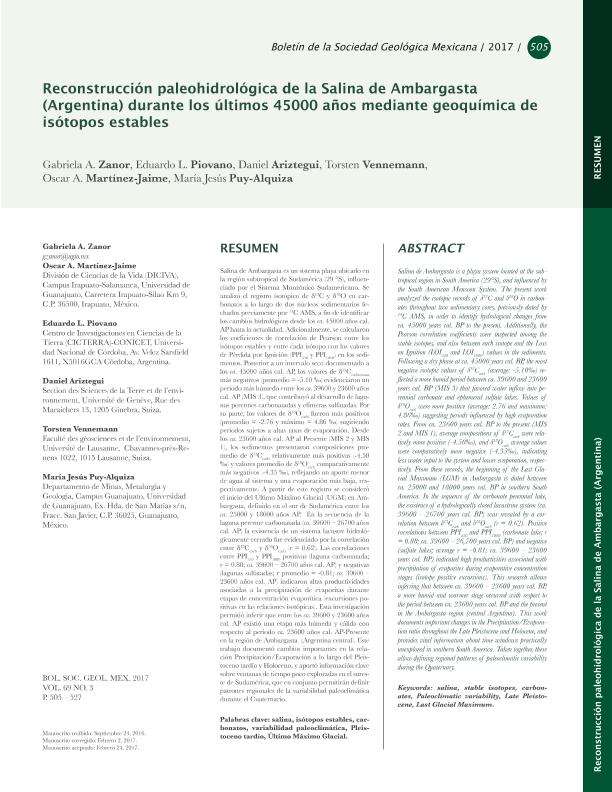Artículo
Salina de Ambargasta es un sistema playa ubicado en la región subtropical de Sudamérica (29 °S), influenciado por el Sistema Monzónico Sudamericano. Se analizó el registro isotópico de δ13C y δ18O en carbonatos a lo largo de dos núcleos sedimentarios fechados previamente por 14C AMS, a fin de identificar los cambios hidrológicos desde los ca. 45000 años cal. AP hasta la actualidad. Adicionalmente, se calcularon los coeficientes de correlación de Pearson entre los isótopos estables y entre cada isótopo con los valores de Pérdida por Ignición (PPI550 y PPI1000) en los sedimentos. Posterior a un intervalo seco documentado a los ca. 45000 años cal. AP, los valores de δ13Ccarbonatos más negativos (promedio = -5.10 ‰) evidenciaron un periodo más húmedo entre los ca. 39600 y 23600 años cal. AP (MIS 3), que contribuyó al desarrollo de lagunas perennes carbonatadas y efímeras sulfatadas. Por su parte, los valores de δ18Ocarb fueron más positivos (promedio = -2.76 y máximo = 4.86 ‰) sugiriendo periodos sujetos a altas tasas de evaporación. Desde los ca. 23600 años cal. AP al Presente (MIS 2 y MIS 1), los sedimentos presentaron composiciones promedio de δ13Ccarb relativamente más positivas (-4.50 ‰) y valores promedio de δ18Ocarb comparativamente más negativos (-4.35 ‰), reflejando un aporte menor de agua al sistema y una evaporación más baja, respectivamente. A partir de este registro se consideró el inicio del Último Máximo Glacial (UGM) en Ambargasta, definido en el sur de Sudamérica entre los ca. 25000 y 18000 años AP. En la secuencia de la laguna perenne carbonatada (ca. 39600 – 26700 años cal. AP) la existencia de un sistema lacustre hidrológicamente cerrado fue evidenciado por la correlación entre δ13Ccarb y δ18Ocarb (r = 0.62). Las correlaciones entre PPI550 y PPI1000 positivas (laguna carbonatada; r = 0.88; ca. 39600 – 26700 años cal. AP) y negativas (lagunas sulfatadas; r promedio = -0.81; ca. 39600 – 23600 años cal. AP) indicaron altas productividades asociadas a la precipitación de evaporitas durante etapas de concentración evaporítica (excursiones positivas en las relaciones isotópicas). Esta investigación permitió inferir que entre los ca. 39600 y 23600 años cal. AP existió una etapa más húmeda y cálida con respecto al periodo ca. 23600 años cal. AP-Presente en la región de Ambargasta (Argentina central). Este trabajo documentó cambios importantes en la relación Precipitación/Evaporación a lo largo del Pleistoceno tardío y Holoceno, y aportó información clave sobre ventanas de tiempo poco exploradas en el sureste de Sudamérica, que en conjunto permitirán definir patrones regionales de la variabilidad paleoclimática durante el Cuaternario. Salina de Ambargasta is a playa system located at the subtropical region in South America (29°S), and influenced by the South American Monsoon System. The present work analyzed the isotopic records of δ13C and δ18O in carbonates throughout two sedimentary cores, previously dated by 14C AMS, in order to identify hydrological changes from ca. 45000 years cal. BP to the present. Additionally, the Pearson correlation coefficients were inspected among the stable isotopes, and also between each isotope and the Loss on Ignition (LOI550 and LOI1000) values in the sediments. Following a dry phase at ca. 45000 years cal. BP, the most negative isotopic values of δ13Ccarb (average: -5.10‰) reflected a more humid period between ca. 39600 and 23600 years cal. BP (MIS 3) that favored water inflow into perennial carbonate and ephemeral sulfate lakes. Values of δ18Ocarb were more positive (average: 2.76 and maximum: 4.86‰) suggesting periods influenced by high evaporation rates. From ca. 23600 years cal. BP to the present (MIS 2 and MIS 1), average compositions of δ13Ccarb were relatively more positive (-4.50‰), and δ18Ocarb average values were comparatively more negative (-4.35‰), indicating less water input to the system and lower evaporation, respectively. From these records, the beginning of the Last Glacial Maximum (LGM) in Ambargasta is dated between ca. 25000 and 18000 years cal. BP in southern South America. In the sequence of the carbonate perennial lake, the existence of a hydrologically closed lacustrine system (ca. 39600 – 26700 years cal. BP) was revealed by a correlation between δ13Ccarb and δ18Ocarb (r = 0.62). Positive correlations between PPI550 and PPI1000 (carbonate lake; r = 0.88; ca. 39600 – 26,700 years cal. BP) and negative (sulfate lakes; average r = -0.81; ca. 39600 – 23600 years cal. BP) indicated high productivities associated with precipitation of evaporites during evaporative concentration stages (isotope positive excursions). This research allows inferring that between ca. 39600 – 23600 years cal. BP, a more humid and warmer stage occurred with respect to the period between ca. 23600 years cal. BP and the present in the Ambargasta region (central Argentina). This work documents important changes in the Precipitation/Evaporation ratio throughout the Late Pleistocene and Holocene, and provides vital information about time windows practically unexplored in southern South America. Taken together, these allow defining regional patterns of paleoclimatic variability during the Quaternary.
Reconstrucción paleohidrológica de la Salina de Ambargasta (Argentina) durante los últimos 45000 años mediante geoquímica de isótopos estables
Zanor, Gabriela Ana ; Piovano, Eduardo Luis
; Piovano, Eduardo Luis ; Ariztegui, Daniel; Vennemann, Torsten; Martínez Jaime, Oscar A.; Puy Alquiza, María Jesús
; Ariztegui, Daniel; Vennemann, Torsten; Martínez Jaime, Oscar A.; Puy Alquiza, María Jesús
 ; Piovano, Eduardo Luis
; Piovano, Eduardo Luis ; Ariztegui, Daniel; Vennemann, Torsten; Martínez Jaime, Oscar A.; Puy Alquiza, María Jesús
; Ariztegui, Daniel; Vennemann, Torsten; Martínez Jaime, Oscar A.; Puy Alquiza, María Jesús
Fecha de publicación:
13/10/2017
Editorial:
Sociedad Geológica Mexicana
Revista:
Boletín de la Sociedad Geológica Mexicana
ISSN:
1405-3322
Idioma:
Español
Tipo de recurso:
Artículo publicado
Clasificación temática:
Resumen
Archivos asociados
Licencia
Identificadores
Colecciones
Articulos(CICTERRA)
Articulos de CENTRO DE INVEST.EN CS.DE LA TIERRA
Articulos de CENTRO DE INVEST.EN CS.DE LA TIERRA
Citación
Zanor, Gabriela Ana; Piovano, Eduardo Luis; Ariztegui, Daniel; Vennemann, Torsten; Martínez Jaime, Oscar A.; et al.; Reconstrucción paleohidrológica de la Salina de Ambargasta (Argentina) durante los últimos 45000 años mediante geoquímica de isótopos estables; Sociedad Geológica Mexicana; Boletín de la Sociedad Geológica Mexicana; 69; 3; 13-10-2017; 505-527
Compartir
Altmétricas



